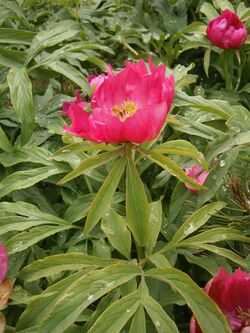Biology:Paeonia officinalis
| Paeonia officinalis | |
|---|---|

| |
| Scientific classification | |
| Kingdom: | Plantae |
| Clade: | Tracheophytes |
| Clade: | Angiosperms |
| Clade: | Eudicots |
| Order: | Saxifragales |
| Family: | Paeoniaceae |
| Genus: | Paeonia |
| Species: | P. officinalis
|
| Binomial name | |
| Paeonia officinalis | |

Paeonia officinalis, the common peony,[1] or garden peony,[2] is a species of flowering plant in the family Paeoniaceae, native to mainly mountainous areas of Southern Europe and introduced in Central and Western Europe and North America.[3]
Paeonia officinalis was first used for medicinal purposes, then grown as an ornamental. Many selections are now used in horticulture, though the typical species is uncommon. Paeonia officinalis is still found wild in Europe.[4]
The cultivar 'Rubra Plena' (deep crimson double flowered) has gained the Royal Horticultural Society's Award of Garden Merit.[5]
Description
It is a herbaceous perennial growing to 60–70 cm (24–28 in) tall and wide, with leaves divided into 9 leaflets, and bowl-shaped deep pink or deep red flowers, 10–13 cm (4–5 in) in diameter, in late spring (May in the Northern Hemisphere).[6]
Distribution
The common peony is native to Europe in Spain , northern Portugal and southern France , Italy, Switzerland , western Romania and the Balkan peninsula and possibly northern Greece (Royal Botanic Garden Edinburgh 1998, Lupo Osti 2006, Aghababian 2011, GRIN 2014). It is widely cultivated elsewhere, but considered a native endemic of Europe.[3]
There are six known subspecies:
- P. officinalis subsp. arietina ((G. Anderson) N. G. Passal.): Native to Italy, Albania and Northern Caucasus.[7]
- P. officinalis subsp. banatica ((Rochel) Soó): Native to Bosnia and Herzegovina, Hungary, Romania and Serbia.[8]
- P. officinalis subsp. huthii (A. Soldano): Native to South-east France and North-West Italy.[9]
- P. officinalis subsp. italica (N. G. Passal. & Bernardo): Native to Italy.[10]
- P. officinalis subsp. microcarpa (Boiss. & Reuter) Nyman): Native to Portugal (Northeast and Estrela, Aire e Candeeiros and Montejunto ranges),[11] Spain and southern France.[12]
- P. officinalis subsp. officinalis: Native to Austria, Switzerland, Hungary, Romania, Slovakia, France, Italy, Slovenia, Croatia, Albania and introduced to the United States in Kentucky, Massachusetts, Vermont, West Virginia and Canada in Ontario.[13]
Taxonomy
Many synonyms exist for Paeonia officinalis, i.e. Moutan officinalis, Paeonia anemoniflora, P. barrii, P. baxteri, P. commutata, P. elegans, P. feminea, P. festiva, P. fimbrata, P. foemina, P. fulgens, P. fulgida, P. hirsuta, P. lanceolata, P. lobata, P. mollis, P. nemoralis, P. paradoxa var. fimbrata, P. peregrina var. officinalis, f. officinalis, P. porrigens, P. promiscua, P. pubens, P. rubens, P. sessiliflora, P. splendens, P. subternata, P. versicolor.[citation needed]
Genetics
The common peony is an allotetraploid with two double sets of chromosomes from different parents (2n+2m=20), so it is a hybrid or nothospecies. One of the parents is most likely Paeonia peregrina. The other parent is one of the group of very closely related species, Paeonia parnassica, P. arietina and P. humilis. Both these parents are tetraploids themselves. P. officinalis has by far the most extensive range and is one of the more abundant species in the Mediterranean region.[14]
References
- ↑ "Paeonia officinalis". Natural Resources Conservation Service PLANTS Database. USDA. https://plants.usda.gov/core/profile?symbol=PAOF2. Retrieved 30 January 2016.
- ↑ (xls) BSBI List 2007, Botanical Society of Britain and Ireland, https://bsbi.org/download/3542/, retrieved 2014-10-17
- ↑ 3.0 3.1 "Paeonia officinalis". IUCN. 14 February 2014. https://www.iucnredlist.org/species/162001/103711428. Retrieved 26 October 2020.
- ↑ Halda, Josef J.; Waddick, James W. (2004). The Genus Paeonia. Timber Press. p. 196. ISBN 978-0-88192-612-5. https://books.google.com/books?id=mDLASKInbjgC&pg=PA196.
- ↑ "RHS Plant Selector - Paeonia officinalis 'Rubra Plena'". http://apps.rhs.org.uk/plantselector/plant?plantid=1372. Retrieved 25 May 2013.
- ↑ RHS A-Z encyclopedia of garden plants. United Kingdom: Dorling Kindersley. 2008. pp. 1136. ISBN 978-1405332965.
- ↑ "Paeonia officinalis subsp. arietina". catalogueoflife.org. http://www.catalogueoflife.org/annual-checklist/2019/details/species/id/8febea2419b0dea1ea3caacd713f0788. Retrieved 26 October 2020.
- ↑ "Paeonia officinalis subsp. banatica". catalogueoflife.org. http://www.catalogueoflife.org/annual-checklist/2019/details/species/id/a427516efbc01a6941dffba6b0292d66. Retrieved 26 October 2020.
- ↑ "Paeonia officinalis subsp. banatica". catalogueoflife.org. http://www.catalogueoflife.org/annual-checklist/2019/details/species/id/206350df5a55874c6da76a142409c040. Retrieved 26 October 2020.
- ↑ "Paeonia officinalis subsp. banatica". catalogueoflife.org. http://www.catalogueoflife.org/annual-checklist/2019/details/species/id/337afc89fcbd276215cb695fd077288f. Retrieved 26 October 2020.
- ↑ "Paeonia officinalis subsp. microcarpa". Flora-on. https://flora-on.pt/#/1Paeonia+officinalis.
- ↑ "Paeonia officinalis subsp. banatica". catalogueoflife.org. http://www.catalogueoflife.org/annual-checklist/2019/details/species/id/db0a92f05f75bfc83701cac3b997663c. Retrieved 26 October 2020.
- ↑ "Paeonia officinalis subsp. banatica". catalogueoflife.org. http://www.catalogueoflife.org/annual-checklist/2019/details/species/id/85355790a6d57c06d8345e918a32486f. Retrieved 26 October 2020.
- ↑ Ferguson, Diane; Sang, Tao (2001). "Speciation through homoploid hybridization between allotetraploids in peonies (Paeonia)". Proceedings of the National Academy of Sciences of the United States of America 98 (7): 3915–3919. doi:10.1073/pnas.061288698. PMID 11259655. PMC 31153. Bibcode: 2001PNAS...98.3915F. http://www.pnas.org/content/98/7/3915.full.pdf. Retrieved 2016-04-30.
External links
Wikidata ☰ Q159738 entry
 |

